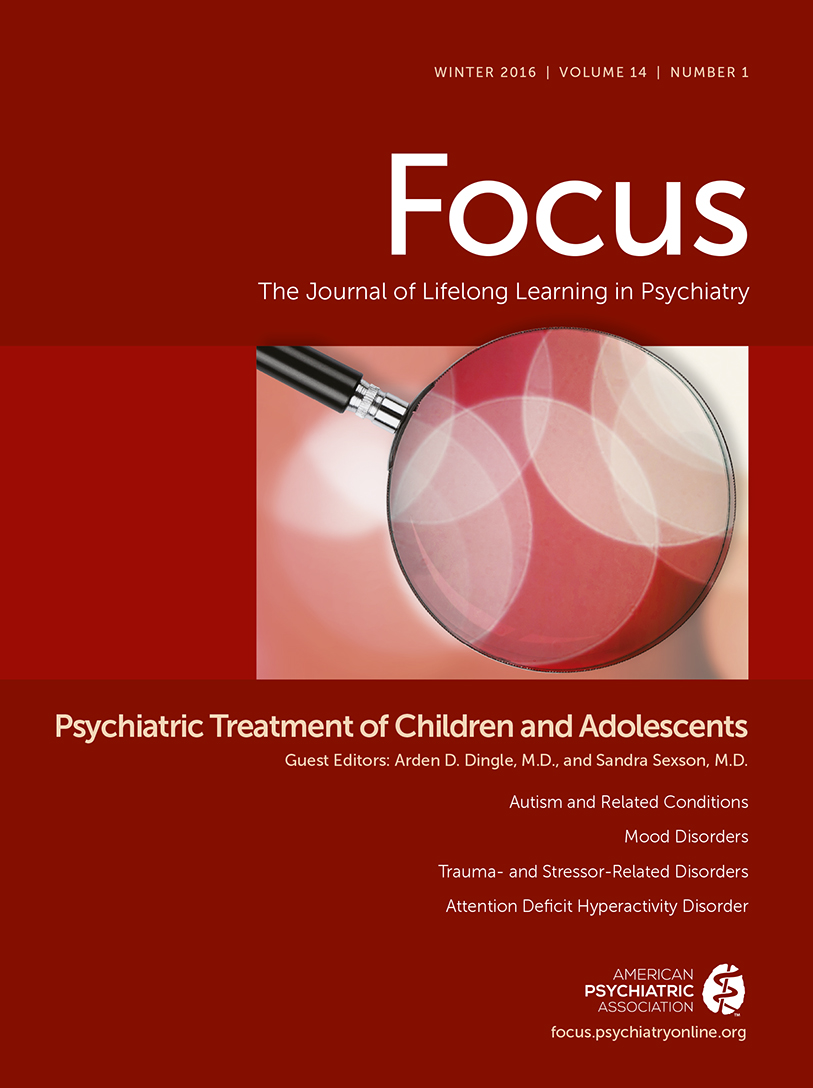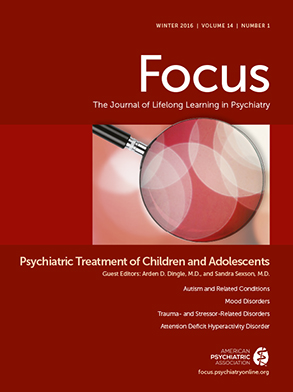It has been apparent for decades that the number of child and adolescent psychiatrists in the United States is markedly inadequate to provide the evaluation and treatment services needed to serve the mental health needs of the more than 15 million children and adolescents (one in five) in the United States who have clinically diagnosable psychiatric disorders (
1). Wait times to see a child and adolescent psychiatrist far exceed the benchmark for access to care established by the Children’s Hospital Association (
2). In fact, it is estimated that only approximately 20% of those in need actually attain mental health services, and a markedly smaller number gain access to treatment by a child and adolescent psychiatrist (
2). In addition, many who receive services do so 8–10 years after they first develop symptoms, losing essential opportunities during these most vulnerable developmental periods to provide preventive and early interventions (
2). This shortage affects practicing general psychiatrists, who often are asked to step into this void to provide services for these impaired youths, particularly in underserved and rural areas. Therefore, it is important to ensure that general psychiatrists have access to ongoing lifelong learning experiences in the area of child and adolescent psychiatry to better facilitate the provision of evidence-based evaluations and treatment of this population.
Continuing education in child and adolescent psychiatry is also important because general psychiatrists need to understand the progression of psychiatric disorders from adolescence into adulthood. According to the American Academy of Child and Adolescent Psychiatry, the onset of at least one-half of psychiatric disorders occurs before middle adolescence, and onset for three-quarters occurs by young adulthood (
2). Given delays in receiving services, the general psychiatrist is likely to see many of these patients first. Therefore, it is imperative that general psychiatrists have a developmental understanding of the evolution of these disorders, and they should be encouraged to seek historical information regarding onset of symptoms and disabilities encountered at earlier ages. Keeping abreast of the continued evolution of both diagnosis and treatment of childhood-onset disorders is vital for the general psychiatrist, who may be seeing these patients either as youths or as young adults.
Furthermore, the general psychiatrist has many patients who are parents, whose psychopathology may well affect the development of their children, and whose stressors may be related to their parenting responsibilities. Being up to date about common disorders in childhood allows the general psychiatrist to recognize early symptoms in the child revealed by the parent, allowing for earlier intervention than is common. In fact, a true generalist might well choose to engage in some “selected” prevention, recognizing that mental illness of parents is a high risk factor for the child or adolescent to develop psychopathology.
The physician providing mental health care to children and adolescents—whether a primary care physician, a general psychiatrist, or a child and adolescent psychiatrist—must keep in mind a number of tenets. Although these tenets are helpful for all age groups, for the most part, they are central to the care of youths with mental illness and include the following:
•
Youths are constantly moving forward developmentally. Their care must be informed by a working understanding of the developmental process, one that can be integrated into clinical assessment and treatment.
•
Children can never be assessed in a vacuum—they live in families, using the broad definition, and are dependent by definition. One cannot ignore the caretakers in the evaluation of youths.
•
Children are constantly changing and look different from day to day. Adequate assessment of the child within the family frequently requires more than one assessment visit and, for most disorders, should include acquiring collateral information beyond the family, including from the child’s school and community.
•
The psychiatric assessment of the child requires the ability to recognize the impact of environmental and psychosocial influences contributing to the child’s symptomatology, along with the high likelihood of comorbidity, leading to a comprehensive formulation based on the four Ps (predisposing, precipitating, perpetuating, and protective factors) or the biopsychosocial model.
•
Interventions for subsyndromal symptomatology are often indicated to prevent further deterioration as well as to address these symptoms, which can be very impairing.
•
Treatment of children almost always begins with psychosocial and psychotherapeutic interventions, which continue even with the addition of psychopharmacology.
•
Psychopathology and functioning of children and adolescents is a dynamic process, requiring frequent revisiting of both diagnosis and treatment options.
•
Finally, the principles of best interest for the child as well as “do no harm” must be maintained.
Keeping these principles in mind is imperative as one addresses the mental health needs of children and adolescents.
In this issue of Focus, experts in broad areas of child and adolescent psychopathology review the state of the art in clinical practice. In addition, they discuss current scientific support for the diagnosis and treatment of common disorders seen in the youth population and alert the reader to directions of future research. All of these disorders progress into adulthood, and they require psychiatric intervention not only for children and adolescents but also for adult patients, for whom an understanding of the historical underpinnings of their condition may inform their treatment. Specific articles address the clinically relevant issues related to attention-deficit hyperactivity disorder; anxiety disorders; autism spectrum disorders; mood disorders, including depression, bipolar disorder, and the new DSM-5 disruptive mood dysregulation disorder; and the trauma-related disorders of posttraumatic stress disorder, reactive attachment disorder, and the new disinhibited social engagement disorder. The Ask the Expert column addresses the need to understand the range of typical development to effectively assess the child.
This issue also includes recently published seminal articles that we and the Focus editors consider critical to the field of child and adolescent psychiatry.
It is our hope that this issue of Focus will provide the practicing psychiatrist, the child and adolescent psychiatrist, and perhaps even the primary care physician with a valuable resource in their ongoing care of children and adolescents who are experiencing not only psychiatric disorders but also psychosocial stressors that impair their ability to progress developmentally.

